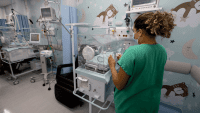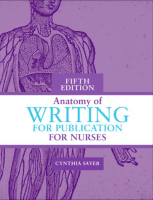A revision of the Florida Nurses Association’s (FNA) organizational plan provided an incentive for members of a local FNA district to reconsider the personal and professional benefits of membership in FNA. Minimal attendance at our district meetings and educational conferences had discouraged our enthusiasm for planning any future FNA projects. Despite these frustrations, our small but committed group of FNA members continued to meet with some regularity; something beside our professional friendship was holding the group together.
Exploring options
One function of the FNA is “promoting the continuing professional development of nurses.” Professional development attracted us as a possible substantive connection between our local district activities and an overall goal of FNA. However, we needed to identify what we could actively engage in at the district level to support this FNA function. Our group began holding a series of informal Saturday morning meetings to explore and reflect on professional interests and aspirations. The meetings were attended by eight nurses who had been members of FNA for 2 to 33 years. Six members had served as a district officer, six had completed graduate school, and five were employed full-time in an academic setting. During the discussions, we recognized our desire to support each other’s professional development as our common, unifying thread. The result of these networking meetings was the creation of our Professional Development Group.
Assessing the group
The first challenge for our Professional Development Group was the identification of what each member would like to accomplish through participation in this special interest group. Our personal hesitancy to design, implement, and complete professional endeavors was identified as a challenge to accomplishing our professional goals. Using a questionnaire designed by two of the group’s members, we discovered each member’s professional interests, goals, and areas of scholarly expertise. Improving writing skills, participating in nursing research projects, collaborating on grant applications, and presenting at nursing conferences were identified as the group’s most common areas of professional interest. The questionnaire also revealed expertise within the group for developing presentations, writing for publication, and engaging in nursing research (see figure below). A result of the questionnaire was the realization that addressing each individual’s scholarly challenges could be done through group collaboration.


Identifying objectives
After analyzing the questionnaire’s findings, short- and long-term group objectives were determined. Short-term objectives for our Professional Development Group included identifying individual projects that would benefit from group expertise. One example of a short-term objective was the strengthening of each member’s Curriculum Vitae and/or resume. Long-term objectives for our Professional Development Group included identifying, developing, and seeking funding for group projects of interest. Contributing to nursing’s body of knowledge through research and publications, a topic of interest for the majority of the group members, was also considered a long term, but important objective.
Since developing presentation skills was identified as a goal for several of the group’s members, the Professional Development Group decided to create a poster for the Florida Nurses Association’s 2009 Centennial Conference. The purpose of the poster was to describe our Professional Development Group’s structures and goals. The group poster project began with the writing and submission of an abstract describing the poster. Since our group’s concept was newly conceived, we were very pleased to receive an acceptance letter from FNA for our poster presentation. Using our Professional Development Group’s survey information, graphics depicting the results were created, the group’s goals and objectives were summarized, and construction of the poster was begun. As the poster presentation progressed from inception to completion, our Professional Development Group passed through many phases of team development. Professional relationships among team members grew as expertise in the different areas of poster presentations was recognized. This first project helped our group grow beyond the confines of professional friendships. Our overall group goal of supporting each other’s professional development at the district level was slowly being accomplished.
Establishing goals
As with any new endeavor, defining success and evaluating outcomes is considered important for a group’s viability. Goals identified by our Professional Development Group members were used to guide the group’s activities and, when accomplished, to measure the group’s success. Our Professional Development Group’s first goal, the creation of presentation materials, was accomplished through the creation of the FNA poster. In addition to meeting the need of some group members to create presentation materials, the poster project allowed the group to develop its work processes and enjoy the benefits of collaboration.
The Professional Development Group’s second goal, the strengthening of each member’s curriculum vitae (CV), was also accomplished. During a meeting focused on the creation and/or strengthening of our professional CVs, the expertise of several group members was very helpful. This goal has been expanded to include the creation of professional portfolios. With agreed upon deadlines in place, workshops have been planned to critique each group member’s professional portfolio.
The opportunity to contribute to nursing’s body of knowledge through publications and research is a third goal of the Professional Development Group. Some potential publications are benefiting from group collaboration, while others are being completed using a one-on-one mentoring relationship. Several members have completed research projects in their work environments and have requested group assistance in writing and submitting the outcomes of their work for publication. In preparation for group research projects, the group identified local Institutional Review Boards (IRB) willing to approve our research proposals. Each member of the group also completed an online research ethics course as part of the IRB approval process. Research evaluating work-related activities across nursing programs continues to be a common area of interest at group meetings. Group members with research expertise have been extremely helpful in identifying the preliminary steps to be taken in beginning a research project.
A fourth goal of our Professional Development Group is to secure funding for research and community-wide projects. Since this was the area of interest with the least amount of group expertise, an expert will be invited to assist us in the identification of grant sources and the submission of grant proposals.
The last goal of our Professional Development Group is the growth of the group’s membership. Our Professional Development Group hopes the support we are providing each other will attract the attention of both current and potential FNA members. Accomplishment of this goal will be achieved by recruiting the minimum number of members needed for recognition as a FNA special interest group.
Creating opportunities
Our Professional Development Group was created as a peer mentoring opportunity for members of a local FNA district who had enjoyed many years of professional friendship. Our actions support Matthew’s belief that professional practice requires nurses to “continue their life-long expansion of knowledge and competency through education and reflective practice”. We recognize the importance of growing, developing, and changing our Professional Development Group’s visions and goals to meet the changing needs of its members. Through our work in this informal network, we believe our Professional Development Group is using reflective practice to promote a dynamic and collaborative image of professional nursing.
Susan Borglund is an associate professor in the School of Nursing, Palm Beach Atlantic University, West Palm Beach, Florida. Cynthia A. Blum is an assistant professor at the Christine E. Lynn College of Nursing, Florida Atlantic University, Boca Raton. Judith Brustad is an assistant academic dean at the Academy for Nursing & Health Occupations, West Palm Beach, Florida. Susan Gillan is an assistant professor in the School of Nursing, Palm Beach Atlantic University, West Palm Beach. Leslie Kent is a professor of nursing at Palm Beach State College, Lake Worth, Florida.
From our readers gives nurses the opportunity to share experiences that would be helpful to their nurse colleagues. Because of this format, the stories have been minimally edited. If you would like to submit an article for From our readers, click here.
Selected references
Florida Nurses Association Bylaws, Article 2, Section 2 Functions. Available at: http://www.floridanurse.org/Resources/documents/2009BylawsFinal.pdf Accessed November 11, 2011.
Matthews J. Nurse educators as specialists in nursing professional development. Virginia Nurses Today. 2009;August/September,/October:8-9.


















